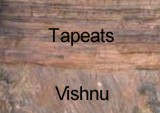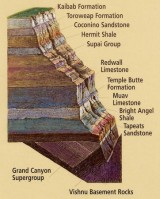Geological Evidence
 |
The most direct way to obtain evidence is to get it yourself. Experience and training help to interpret what you see. For instance, the rocks of the Grand Canyon can be read by experienced geologists to reveal what past events shaped the landscape in that specific instance and as an example of the same processes that were, and are still, active all over the world.
Vishnu Basement Rocks
The bottom layer of rocks that are visible in the inner gorge of the Grand Canyon are composed of intrusive rocks as well as clays and muds that have been changed by high temperature and pressure about 1.7 billion years ago. The resulting metamorphic rocks provide an indication of the conditions that affected them in the past. Their composition tells us about the environment in which they originated.
Sedimentary Rocks
Grand Canyon Supergroup
From approximately 1250 million to 700 million years ago, sediments of primarily marine origin and volcanic extrusives accumulated in horizontal layers over the highly eroded Vishnu Group rocks to a depth of several miles. These Precambrian formations, collectively known as the Grand Canyon Supergroup, were subjected to extensive faulting and tilting after their deposition. Erosion completely removed the Supergroup from most places in the Grand Canyon. The lack of this layer of rocks is called the Great
Unconformity - a major gap in the expected sequence of rock strata.
Encroachment by the Cambrian sea also eroded part of the Vishnu prior to the beginning of the Paleozoic Era. Remnants of the original Supergroup layers are exposed along some faults in the Canyon, but have been tilted. The earliest record of life in Grand Canyon rocks are stromatolite fossils found in the oldest layer of the Supergroup.
Paleozoic Formations
The Kaibab Limestone, Toroweap Formation, Coconino Sandstone, Hermit Shale, Supai Group, Redwall Limestone, Muav Limestone, Bright Angel Shale, and Tapeats Sandstone are all sedimentary rocks of Paleozoic Era origin. They are stacked one upon the other in an orderly and continuous fashion. The Tapeats, lowermost of the Paleozoic strata, was deposited approximately 550 million years ago.
Deposition TimesFrom approximately 1250 million to 700 million years ago, sediments of primarily marine origin and volcanic extrusives accumulated in horizontal layers over the highly eroded Vishnu Group rocks to a depth of several miles. These Precambrian formations, collectively known as the Grand Canyon Supergroup, were subjected to extensive faulting and tilting after their deposition. Erosion completely removed the Supergroup from most places in the Grand Canyon. The lack of this layer of rocks is called the Great
 |
Encroachment by the Cambrian sea also eroded part of the Vishnu prior to the beginning of the Paleozoic Era. Remnants of the original Supergroup layers are exposed along some faults in the Canyon, but have been tilted. The earliest record of life in Grand Canyon rocks are stromatolite fossils found in the oldest layer of the Supergroup.
Paleozoic Formations
The Kaibab Limestone, Toroweap Formation, Coconino Sandstone, Hermit Shale, Supai Group, Redwall Limestone, Muav Limestone, Bright Angel Shale, and Tapeats Sandstone are all sedimentary rocks of Paleozoic Era origin. They are stacked one upon the other in an orderly and continuous fashion. The Tapeats, lowermost of the Paleozoic strata, was deposited approximately 550 million years ago.
Comparisons with the same rock strata in other areas, paleomagnetic data, radiometric dating, and the discovery of additional microfossils provide the information to determine ages of the rock strata and the times during which they were deposited. Such information allows geologists to correlate Grand Canyon rocks with rock formations found in other places.
Excerpted and adapted from: Vishnu Basement Rocks, Grand Canyon Supergroup, Schist, Basement Rocks of Grand Canyon, The Great Unconformity, Overview of the Grand Canyon Supergroup